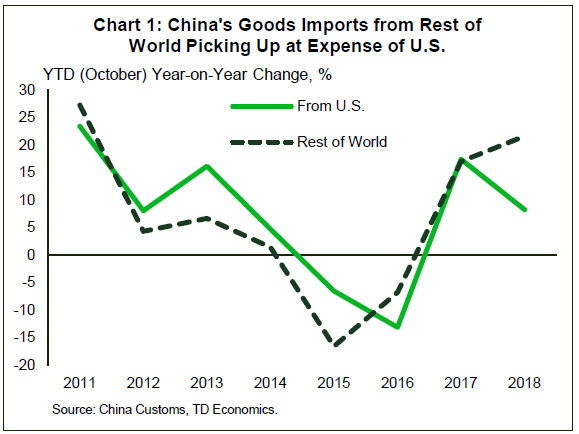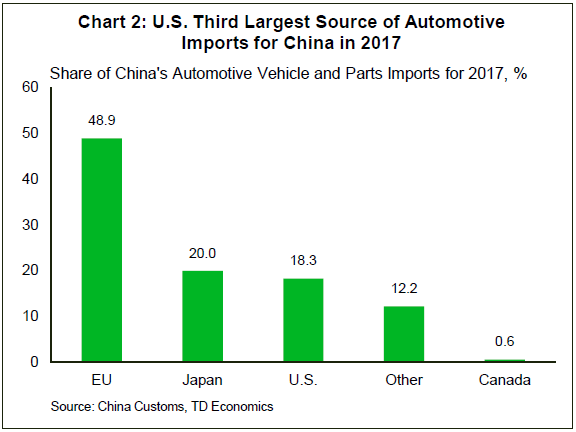- Over the weekend the U.S. reached a deal with China, promising to delay increasing its 10% tariff to 25% on $200bn in Chinese imports by 90 days. The hope is that the two economic giants can come to some agreement during that period to avoid escalation. Although the G20 statements by both countries lacked specifics on firm commitments, global financial markets welcomed the news with enthusiasm, since the meeting proved a bit more fruitful than many expected.
- Importantly, the agreement in principle serves to alleviate the most pressing concerns regarding the jump in the tariff rate come January 1st, further retaliatory action by China and the U.S., and the potential economic and financial market fallouts. The U.S. comes out the winner, giving up very little while potentially gaining in the near-term from a rebound in exports to China. But, we caution that tariffs remain in play, and so too does uncertainty over the corporate landscape. This is likely to continue to weigh on business investment decisions and lead to bouts of market volatility in the year ahead if a concrete resolution does not occur over that 90-day period.
Details Limited to Promises
- China has reportedly agreed to a number of concessions that opened the window to further dialogue through March of next year. Effective immediately, China has committed to a very substantial, but not yet agreed upon, increase in the amount of agricultural, energy, and other products it imports from the U.S. annually. The goal is to reduce its trade deficit with the U.S. Furthermore, negotiations on structural changes to China’s forced technology transfer, intellectual property rights, cyber intrusions and theft, non-tariff barriers, and services and agriculture are to begin immediately. The aim is to have a plan to resolve these issues in place within the next 90 days to avoid an escalation in tariffs to 25%.
- On the foreign policy front, China has agreed to work together with the U.S. and North Korea towards a nuclear free Korean Peninsula.
- Less attention grabbing, but importantly, China agreed to designate fentanyl as a controlled substance. This would expose fentanyl exporters to the U.S. to maximum penalties under Chinese law. The CDC reported recently that drug overdose deaths in the U.S. have rocketed to more than 70,000 in 2017, with deaths resulting from fentanyls surging 45% in 2017 to more than 28,000. The increase in opioid related fatalities over the past few decades have been implicated in reducing average life expectancy in the U.S., and has had negative economic implications since the majority of deaths are occurring in the core working age population of 25-54.
China Extends Previous Commitments to the United States…
- There has been some fanfare regarding China’s promise to increase shipments from the U.S. and lower tariffs on U.S. goods. However, China had previously promised similar outcomes to other trade partners in an attempt to court them to its side of the trade spat. And, they appear to have been executing with some precision on this front. The growth-gap between that of Chinese imports from the U.S. versus the rest of the world widened to the largest level since 2003 (Chart 1).
- So, the agreement over the weekend ultimately serves to avoid marginalizing U.S. companies further from China’s ambitions to boost imports and reduce its trade imbalance with the world.
- Of the other concessions agreed to by China, it has also been rumored that auto tariffs will decline substantially. This has two parts. First, China had imposed hefty retaliatory tariffs on the U.S. auto imports following the U.S. administration’s 25% tariff on an additional $16bn in Chinese imports this past August. That caused the average tariff rate to jump from 15% to 40%. This is expected to be rolled back to 15%, consistent with Chinese tariffs on other imported autos, and could reduce some to zero according to claims by the U.S. administration. Given that China has a habit of extending duty reductions to WTO member countries, any further reduction in tariffs on autos in the U.S. are likely to also apply to its other trade partners (Chart 2).
- The commitment to increase agricultural imports should help support prices for U.S. agricultural goods that are commonly exported to China, such as soybeans and pork. Indeed, the front contract price for U.S. soybeans is up over 1% today on the news, but is still well below the highs witnessed before the U.S. enacted its first round of tariffs on $34bn in Chinese goods this past July.
- While a step in the right direction, the 90 day window for negotiations may be insufficient time for both parties to resolve issues concerning intellectual property violations, corporate espionage, and the deeper structural issues that advantage China over its competitors. Instead, dialogue is likely to result in a constructive framework for further dialogue, with the threat of an escalation in tariffs hanging over the whole process.
…While the U.S. Administration Capitulates to a Growing Chorus of Domestic Objections to Tariffs
- Financial markets have been quick to react to every headline about tariffs on China. This has been generating additional market volatility on top of that driven by the Federal Reserve’s interest rate normalization and the deteriorating global economic backdrop. The dramatic selloff that began in October following the September 24th imposition of a 10% tariff on $200bn in Chinese imports likely partly reflected concerns of further escalation in trade tensions between the U.S. and its trading partners.
- U.S. businesses have been expressing their discontent over tariffs for months now. Survey data show that the tariffs have been causing a run on available supply, resulting in higher prices and causing all sorts of volatility with inventories and supply chains, including component shortages. These concerns were repeated in the Feds monthly Beige Book publications. Moreover, the threat of further escalation is weighing on business sentiment globally, and is likely a factor in the declining growth in global trade volumes, while also threatening to reduce business investment.
- These concerns, and the threat of further escalation, have the Fed now seriously considering the economic implications of the tariffs as it looks to update its economic projections and, more importantly, its interest rate guidance for the December 19th monetary policy meeting.
Not a Major Game Changer for the U.S. or Global Economic Outlook
- Ultimately, the 90 day negotiation window buys the U.S. administration time, but doesn’t provide enough of an escape hatch to alleviate the U.S. administration’s concerns regarding China’s record of business practice malfeasance. As such, the threat of an escalation in tariffs is likely to continue to weigh on business sentiment globally, and could persist as a drag on business investment.
- Our impact estimates suggest that a follow-through of the threat to raise the tariff rate to 25% from 10% could result in a further 0.13 ppt level drag on U.S. GDP growth through 2020. This is the least of concerns, given that financial market volatility risks undermining overall global confidence. Given recent developments, we plan on holding off embedding any direct impacts and observe developments. But, we will still be incorporating some negative drag on growth to account for trade uncertainty that is likely to continue to restrain domestic business investment.















